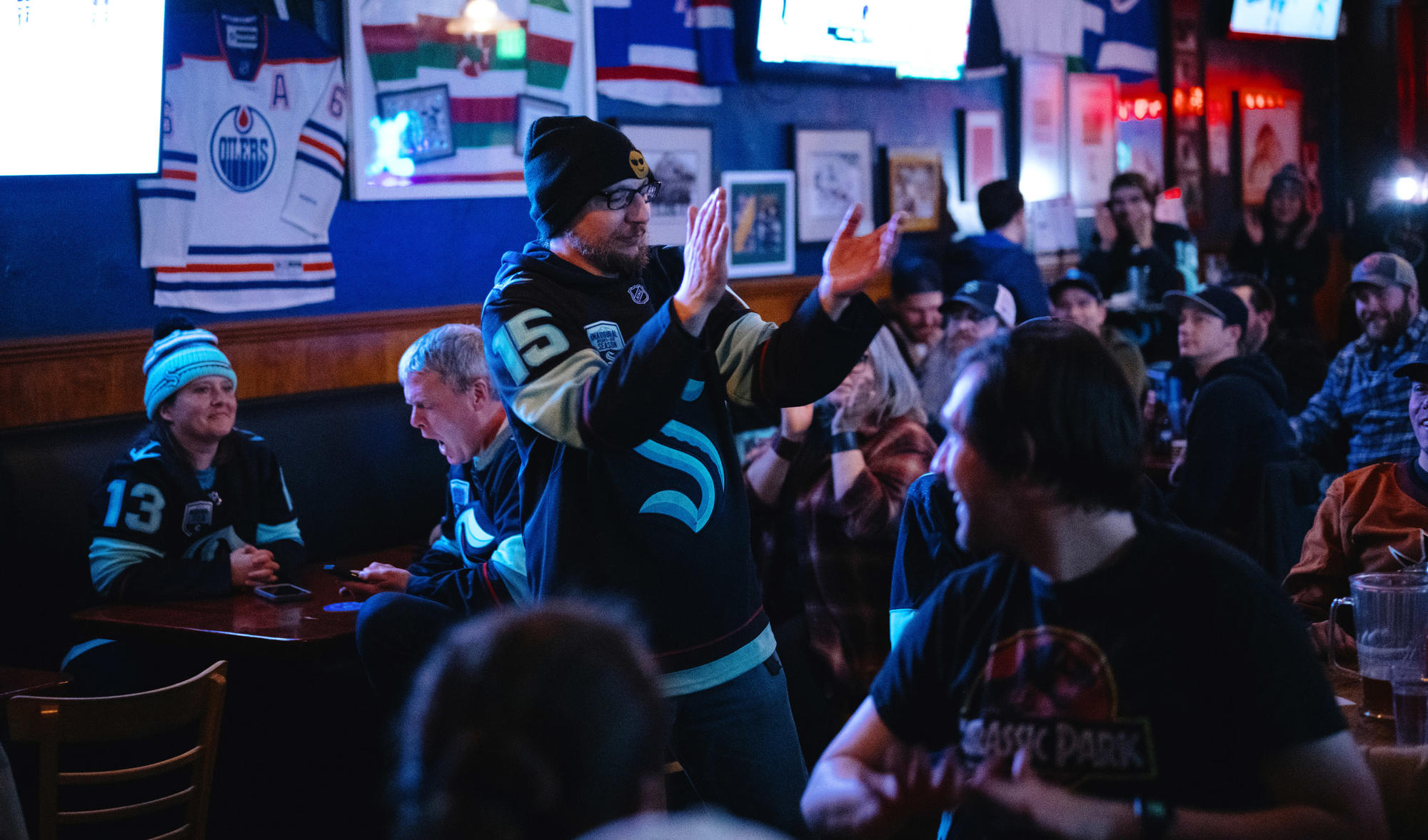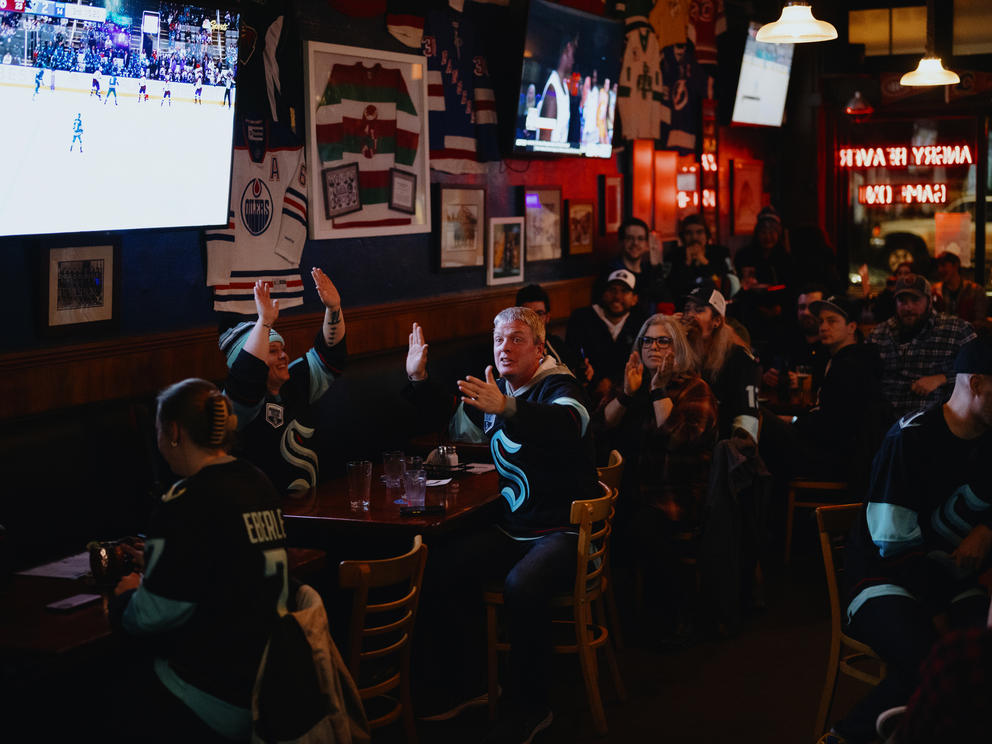Raised on the pick-up pond-hockey culture of Toronto, Pipes opened The Angry Beaver in 2012 as a space for fans of the sport – and because he was tired of asking reluctant Seattle bartenders if they would change the channel to watch hockey.
He didn’t expect Seattle would have its own NHL team a few years later. And in the depths of last year’s rocky season, he definitely didn’t expect that the Kraken would soon be a playoff team.
Now, the Stanley Cup Playoffs are kicking off today (April 17) with the Kraken locked into the first of two wild-card slots in the Western Conference. And last week, the Kraken became the second team in league history to reach the milestone of 100 points in one of their first two seasons.
How can I watch the Kraken playoff games?
Tickets for the first home game (Saturday, April 22) against the Colorado Avalanche are on sale. If you’re dead-set on going to a home playoff game, expect Ticketmaster queues and prices higher than the already-expensive regulation home games. If you do score seats, arrive early so you don’t miss the pregame opening – which includes a light show and robotic tentacle descending from Climate Pledge Arena’s rafters.
The franchise also sponsors watch parties at the Kraken Community Iceplex at Northgate and at bars in Seattle and elsewhere in the Pacific Northwest.
If you prefer to watch from the comfort of your couch, the best bet for local streaming is through Root Sports on DIRECTV and Fubo. ESPN+ also airs games live, but some are sold to regional broadcasters and blacked out from regional viewing.
You can listen to game radio feeds though KJR-FM, the NHL app and website, or SiriusXM.
I’ve never seen an ice hockey game, what are the rules?
How many players are on the ice? Each team has six players: a goalie, two defensemen, and three forwards. After each play begins with a face-off, players will often substitute line changes while the puck is still in play. Skating is exhausting and hockey moves quickly – usually each offensive and defensive line’s shift lasts only about 45 seconds.
Off-sides: A team can’t cross into their offensive zone with the puck if another player on their team is already over the blue line. FYI: Refs call off-sides based on a player’s skates, not their stick.
Icing: In regulation, a player in one zone can’t hit the puck all the way through center ice and over the red goal line on the other side of the rink This rule is to prevent teams from constantly slinging the puck out of play, which would not be fun hockey to play or watch.
Penalties: A penalty that takes a player off the ice results in a power play for the other team – the advantage of having one more skater on the ice while the offending player waits in the penalty box. Minor penalties (tripping, hooking, slashing, etc.) require two minutes in the box. Compared to other major league sports, minor penalties in hockey are common. Major penalties (five minutes) and penalty shots are less frequent.
Is fighting legal?: Sort of. It’s a penalty, but it is much more a part of gameplay than in other team sports. Throwing punches is most frequently called as a major penalty (“five for fighting”). Aside from longstanding tradition, fighting isn’t altogether banned because it can hold players accountable in a very physical game. If there’s a dirty hit or if anyone on the other team makes contact with the goaltender, there’s an unwritten expectation for players to defend their teammates. That being said, players don’t always drop the gloves for such chivalrous reasons – sometimes smack talk or competitive egos make them lose their heads.
Why are the Kraken doing so well this year?
Despite the fanfare of the shiny new franchise and arena, the Kraken’s first season was rocky. In 2021-2022, Seattle finished second to last in the Western Conference with 60 points: 30th place out of 32 teams in the league.
So what changed? Every fan will have a theory, but the general consensus is that the team’s depth of scoring talent, puck possession and teamwork vastly improved since their inaugural year.
A highlight of the regulation season was a sweep of seven wins on a seven-game road trip in early January – a feat that made NHL history. Seattle generally plays well even without the home-barn advantage: This year, 20 of the team’s 46 season wins have been on the road.
The only other team in league history to reach a 100-point campaign so early after signing were the Las Vegas Golden Knights, who joined the NHL in 2017. During the Golden Knights’ expansion draft, team management was bullish in cherry-picking successful players from other franchises. They ended up with a historic first-year run, coming off the bench their inaugural season as Stanley Cup runner-ups.
“I think the expectation in Seattle was that we were going to approach this a little more cautiously and look towards the future as far as not spending our whole salary cap right away, you know, get some younger kids in on a team and also some veteran talent,” said The Angry Beaver owner Tim Pipes. “And I think everybody here is certainly surprised.”
A few key acquisitions paid off well for the Kraken, and no moves from the team management on the March 3 trade deadline signaled that head coach Dave Hakstol and GM Ron Francis had deep trust in the lineup they had already built.
“Let’s keep doing things that nobody outside of this room thinks we can accomplish,” said Hakstol in a video of the locker room after the April 6 postseason clinch. “It’s really important for our fans. It’s really important for our city. It’s big for the state.” And, finally, in his signature stiff, commanding monotone: “We’re in the f****** playoffs, boys.”
How does the series work?
Much like a playoff beard, stats can get hairy quickly. Playoff seeding is determined by simple overall season standings: Teams get two points for a win and a single point for an overtime or shootout loss. Let’s break it down.
There are two conferences in the NHL: Eastern and Western. Each has two divisions: Eastern has the Atlantic and Metropolitan Division, and Western has the Central and Pacific Division. The top three teams in each division qualify automatically, and each conference gets two wild-card spots for the next highest-scoring teams. That means that 16 of the league’s 32 teams make it to the playoffs.
The Kraken play in the Pacific Division of the Western Conference. They’re entering the postseason fourth in the Pacific behind the Golden Knights, Edmonton Oilers and L.A. Kings. The Winnipeg Jets took the division’s second wild-card spot.
During a playoff campaign, a lot of math goes into calculating playoff positions in each conference. If numbers make your eyes glaze over, the good news is that you don’t need to know much about points to follow a game of hockey.
The playoff bracket is a best-of-seven game series in four rounds. The Stanley Cup Championship usually lands in mid-June. It’s hard to predict what will happen in the tournament. Upsets are relatively common, although a wild-card team hasn’t won the cup since the modern system started in 2014.
The Kraken are locked in to face the Colorado Avalanche in the first round of the playoffs.
In the regular season, teams go to a shootout to determine a winner after an overtime period. That’s not the case in postseason hockey. Instead, games tied in regulation time will continue in sudden-death overtime until the puck lands in a net.
Who’s on the ice?
Folks on the Kraken lineup mostly hail from Canada, with a few Americans and Europeans. Rather than a single captain, the team this year has a group of alternate captains: Jordan Eberle, Yanni Gourde, Adam Larsson, and Jaden Schwartz.
Professional hockey has an endless string of nicknames, and Seattle is no exception. At 6’7”, Jamie Oleksiak is “Big Rig.” Eeli Tolvanen – a winger acquired halfway through the season – is “Goalvanen” (although that one probably isn’t as common in the locker room). Jordan Eberle is “Ebs.” Jared McCann is “Canner.” Brandon Tanev is “Turbo.” Wenny. Gourdy. Borgy. The list goes on.
Most often in goal is Philipp Grubauer (don’t mistake the echoing chorus of “Gruuuuuuuuuu”s at home games for booing). After a rocky start to the season – including a groin injury that had him out for a month in November – his season save percentage is .895%. Gru is also the highest-paid Kraken player with a six-year, $35.4 million contract, which shook out this season to a base salary of $6 million. Also in net is Martin Jones (.887%), traded from the Philadelphia Flyers last year. On backup with four starts so far is Joey Daccord, who played this season for the Coachella Valley Firebirds, an American Hockey League (AHL) affiliate team owned and operated by the Kraken.
Leading the offense in points (total goals + assists: 70) and goals (40, and ahead by a mile – Matty Beniers trails at 24) is center Jared McCann. McCann has played in the league since 2015, when he began with the Vancouver Canucks. With 63 points, right wing Jordan Eberle is a seasoned player who has been in the league since 2009.
Eberle is followed by 20-year-old Beniers with 57 points – the most of any rookie in the NHL. The center is a leading contender for the Calder Trophy, awarded to the first-season player of the year. Also notable: Beniers has served only two minutes in the box this season. Yanni Gourde, on the other hand, has racked up 76 penalty minutes. That total includes four fighting infractions – he’s known to play scrappy and is quick to drop the gloves. Gourde had 48 points in the regulation season.
Down at the blue line, it’s been a breakout season for Vince Dunn, who was second only to McCann in points (64) and leads defenders with 14 goals.
Fans have been badly missing winger André Burakovsky, who led scoring until an injury paused his season in February. It’s unlikely he’ll appear in the playoffs.
Local league lore
Although this is the Kraken’s first NHL playoff appearance, it’s not Seattle’s. The Seattle Metropolitans made the playoffs seven times in their nine-year run from 1915 to 1924, and the team even won the Stanley Cup in 1917. That win made the Metropolitans the first American team to win the Stanley Cup and the first Seattle team to win a world championship.
The “S” emblazoned on Kraken jerseys was designed in homage to the Metropolitan’s logo. There’s also a nod to Seattle hockey of yesteryear in Adidas’ Reverse Retro jersey line, whose striped sweaters were inspired by the lesser-known Ironmen of a semi-pro Pacific Coast Hockey League in the 1940s and ’50s.
Over the years, Tim Pipes has collected stacks of boxes filled with Seattle hockey memorabilia, photos and keepsakes that people give to him or donate to the bar, sometimes after family passes away.
“It's a scrapbook of all this old hockey history, you know, newspaper clippings from the ’30s, ’40s and ’50s. And so I've held on to all that stuff,” said Pipes. “I was surprised, really – being in this rainy city that doesn't really get any winter per se – how deep the hockey roots were here.”
The National Hockey League is rich with tradition, but the playoff beard might be the most notorious. The rules are simple: begin growing your beard once the regular season ends. No trimming or shaving allowed until you’re either eliminated or have the Stanley Cup in hand.
The superstition has been around since the 1980s, when two players on the Detroit Red Wings tried to inspire a string of wins. It caught on. The practice has spread to every level of hockey and other sports leagues, including the NFL and MLB. Even some devoted fans will participate.
As a new team, the Kraken are starting to forge their own traditions, too.
One is the Davy Jones hat. The elaborate wide-brim hat, based on the Pirates of the Caribbean character’s costume, is used as a player-of-the-game award. Each winner from the previous game hands it off to the next in a locker-room ritual often documented by the franchise’s social media team.
There’s also the mysterious and mythical luck of the new sea-troll mascot. Named Buoy, the mascot (“nephew” of the Fremont Troll) was introduced before a preseason game in October to a lukewarm reception. Fans seem to be begrudgingly warming up to Buoy and his chipped-tooth perma-grin, blue mullet-like hairstyle and ear hair to match.






